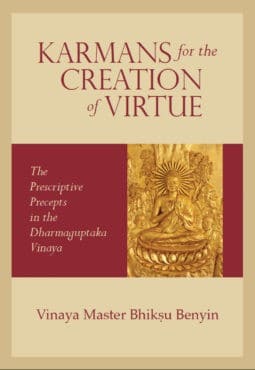
Karmans for the Creation of Virtue
The Prescriptive Precepts in the Dharmaguptaka VinayaTeachings by Vinaya master Bhikshu Benyin on the activities in which monastics should engage in order to preserve the monastic lifestyle. This text is best read by fully ordained Buddhist monastics.
Order from
This text is best read by fully ordained Buddhist monastics.
Do not say after my parinirvana that pure practitioners have no protector. Now that I have taught the ‘Pratimoksa Sutra’ and the excellent vinaya well, regard these as the World-honored One after my parinirvana. —Sakyamuni Buddha in the “Pratimoksa Sutra”
About the book
Nearly 26 centuries ago in India, our world had the extraordinary great fortune to have the appearance of a fully awakened Buddha who turned the wheel of Dharma. His teachings spread and flourished throughout Asia and, in the last century or two, have spread to Europe, the Americas, Australia, and Africa as well.
The Buddha gave us three “baskets” of teachings—the vinaya, the sutras, and the abhidharma—all of which must be studied and practiced to maintain Buddhism as a living tradition. While all practitioners can engage with the sutras and abhidharma, it is only the sangha—the communities of fully ordained bhiksus and bhiksunis—that commit themselves to practicing the vinaya, the monastic code of conduct established by the Buddha. Thus sangha communities are necessary for the preservation of the Buddha’s complete doctrine. The existence of these communities in a land is the measure of the Buddhadharma flourishing in that place.
Traditionally, the sangha has been entrusted to learn and pass down the Buddha’s teachings from one generation to another. While lay practitioners are equally able to practice the Dharma, the existence of monasteries and temples lets society know that there are specific places where they can go to learn the teachings as well as to practice together with others who are dedicated to transforming their minds by living ethically and generating compassion and wisdom. To transmit the entirety of the Buddhadharma to a new land, it is essential that there are monastics who learn the vinaya and use it to guide their daily lives. They must train in both the prohibitive and prescriptive precepts, the prohibitive precepts being actions to abandon, the prescriptive precepts being activities that the sangha should engage in.
In Karmans for the Creation of Virtue: The Prescriptive Precepts in the Dharmaguptaka Vinaya, Vinaya Master Bhikshu Benyin explains the activities in which monastics should engage, specifically the three types of karmans or transactions. Transcribed from his oral teachings in Chinese by Bhikshuni Jendy, translated into English by Bhikshuni Ruixiong and Lynne Mallinson, and edited by Bhikshuni Thubten Chodron, this book is a valuable contribution to the growing body of vinaya literature in English.
